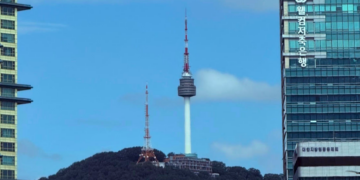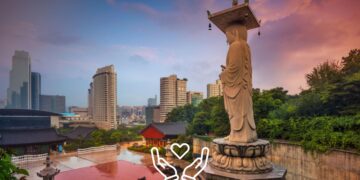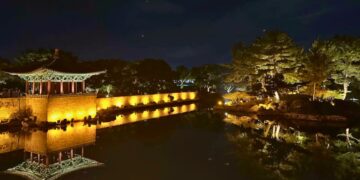Last Updated on 7 days by admin
Korea’s Malls Are No Longer Just Shopping Centers — They’re Becoming Tourism Engines
This holiday season, LOTTE World Mall launched its “Super Mario Joyful Holiday” event in collaboration with Nintendo Korea. At first glance, it looks like a festive photo-zone activation — bright décor, character installations, themed zones, and retail tie-ins designed to bring families and tourists into Jamsil.
But the deeper story is this:
Korea has become Asia’s most competitive testbed for experiential tourism, and global brands are now designing physical activations in Seoul not simply to entertain — but to measure consumer behavioral shifts, stimulate retail foot traffic, and capture fandom-driven demand.
Nintendo’s event is one case within a much larger trend redefining how travelers interact with Korean retail spaces.
Seoul Is Emerging as Asia’s Experiential Retail Capital
The rise of experiential tourism didn’t happen suddenly. It accelerated after the pandemic, as consumers demanded interactive, IP-rich travel moments. Instead of shopping for products, visitors increasingly “shop for experiences.”
Korea’s malls responded faster than almost any market worldwide:
- Pokémon pop-ups drawing 8-hour lines
- Line Friends & Kakao Friends flagships are becoming tourist attractions
- Disney immersive experiences are selling out entire weekends
- Starfield’s cultural spaces are attracting travelers who don’t shop at all
LOTTE World Mall’s Mario-themed holiday project sits squarely in the middle of this evolution.
Korea Is Becoming Asia’s Experiential Tourism Capital
In the past few years, Seoul has evolved from a shopping destination into a full-scale experiential city. Travelers no longer fly to Korea simply for fashion or cosmetics. They come for interactive, photogenic, IP-themed experiences that blend entertainment, culture, and retail.
The numbers tell the story:
- Korea’s inbound tourism in 2024 rebounded to 82% of 2019 levels, outpacing most Asian markets.
- Tourists now spend an average of ₩1.31 million on retail, according to KTO data — much of it influenced by character IP and experiential attractions.
- Character licensing in Korea continues to grow at double-digit rates, signaling strong demand for IP-driven visitor experiences.
This ecosystem is the reason global IP owners — from Pokémon and Disney to LINE Friends and Sanrio — frequently launch their biggest pop-ups in Seoul.
Nintendo and Super Mario have simply become the latest additions to this expanding cultural trend.
Inside the LOTTE × Nintendo Event: Experience First, Commerce Second
The “Super Mario Joyful Holiday” activation transforms LOTTE World Mall into a vibrant, family-friendly holiday space inspired by Nintendo’s legendary universe. Visitors can explore themed photo zones, Christmas installations, and curated retail areas built around Mario’s iconic world.
But beneath the decorations lies a strategic business move:
LOTTE isn’t selling products — it’s selling an experience
And these experiences matter as they:
- keep visitors inside the mall for longer.
- encourage tourists to add LOTTE World Mall to their Seoul travel itinerary.
- increase engagement across multiple floors and stores.
- boost seasonal foot traffic during the highest-spending quarter of the year.
Nintendo gains something too:
A physical cultural footprint in one of the world’s most digital gaming markets. By bringing Mario into the real world, Nintendo strengthens brand recognition among families, tourists, and the MZ consumer segment, who drive viral content trends.
Experiential Retail Is Now Driving Korea’s Tourism Economy
The Super Mario holiday event fits into a broader transformation happening across Korea’s retail landscape: the shift from transactional shopping to immersive engagement.
Industry data shows:
- Experiential retail zones increase visitor spending by 20–60%.
- Immersive activations often boost mall-wide conversion rates by 30–40%.
- Indoor mall traffic in Korea has now surpassed pre-pandemic levels at 105% of 2019.
This is why malls like LOTTE, Hyundai Seoul, and Starfield no longer behave like traditional shopping centers. They operate more like entertainment venues or theme parks, offering multi-sensory, photo-friendly experiences that blend travel, culture, and fandom.
For tourists planning a trip to Seoul in 2025, these experiential spaces are becoming just as essential as Gyeongbokgung Palace or Myeongdong.
How IP Tourism Is Reshaping Korea’s Travel Economy
One of the most important travel shifts in the region is the rise of IP tourism — travelers visiting destinations specifically for character-driven or franchise experiences.
In Korea:
- Nearly 1 in 3 inbound visitors participates in an IP- or fandom-related activity.
- Pop-ups like Pokémon, Disney, and Sanrio generate lines lasting hours and attract foreign travelers who plan entire itineraries around them.
- Video-game, anime, and character tourism continues to rise among visitors from Japan, Taiwan, Singapore, and Hong Kong.
Nintendo’s Super Mario event simply reinforces Seoul’s position as the regional hub for IP-based travel.
Why Global IP Uses Korea as a Testing Ground
Korea’s experiential landscape functions like a “cultural laboratory” for global brands. The reason is simple: what succeeds in Seoul can often scale globally.
Several dynamics explain this phenomenon:
1. Fast Feedback Loop
Korean consumers signal instantly what they love — lineups, social posts, reviews — giving brands immediate insights.
2. High Viral Potential
Events in Korea often spread through regional social media, especially in Japan, Taiwan, and Southeast Asia.
3. MZ Consumer Behavior
Korea’s MZ generation values brand storytelling and identity — exactly what IP activations deliver.
4. Retail Conglomerates as Media Platforms
LOTTE, Shinsegae, and Hyundai are no longer just landlords. They are content producers competing for cultural attention.
This means even one holiday pop-up can generate regional momentum.
What This Signals for 2025 and Beyond
The Mario holiday activation hints at several upcoming shifts in Korea’s tourism and retail sectors:
More global IP collaborations
From gaming franchises to animation studios, brands will increasingly use Seoul as a launchpad for global experiential campaigns.
Travel itineraries centered on malls and pop-ups
Jamsil, COEX, and Yeouido are becoming essential destinations for inbound travelers seeking curated experiences.
Hybrid spaces blending retail, culture, and entertainment
Future malls will behave more like cultural districts, offering layered experiences instead of retail-only floors.
Integration of AI, AR, and interactive storytelling
The next generation of pop-ups will merge physical installations with digital immersion, gamified quests, and collectible digital rewards.
Korea’s ability to merge tourism, fandom culture, and experiential design is setting a global standard.
Final Takeaway
The “Super Mario Joyful Holiday” event at LOTTE World Mall is more than a festive celebration — it’s a powerful symbol of how Korea leads the global shift toward experiential tourism. By merging global IP with immersive design, LOTTE and Nintendo have created a moment that appeals to both travelers and locals, shaping how malls and retail ecosystems will evolve in the coming years.
For tourists, it’s a must-visit seasonal attraction.
For brands and industry operators, it’s a signal:
Korea and mainly Seoul is now one of the world’s most influential markets for experiential retail and IP-driven tourism.
Related Posts
430 total views, 10 views today

















